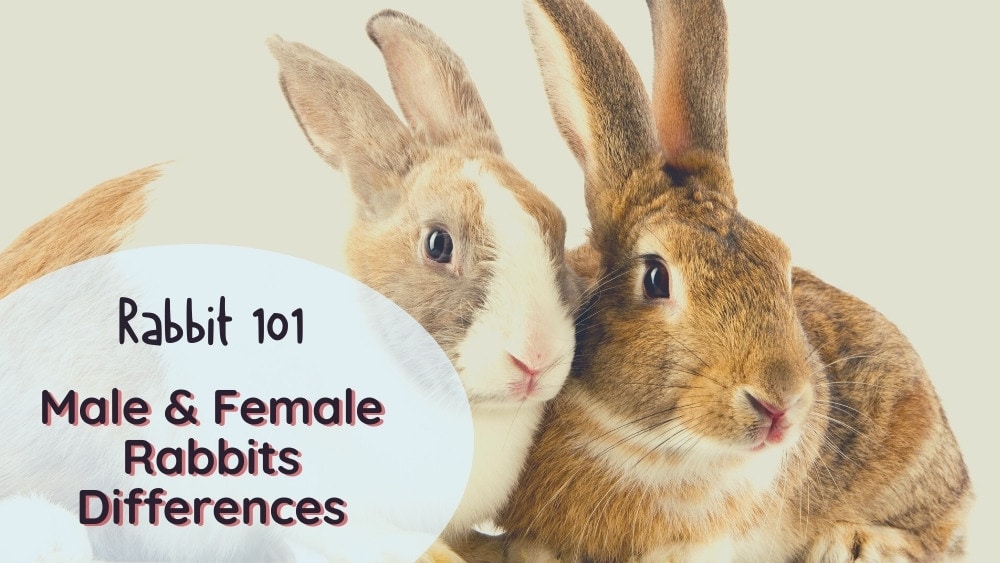Rabbits make excellent pets for the right owner. Yet many people don’t realize just how different male and female rabbits can be, especially regarding their behavior.
Understanding male and female rabbits differences can help you make the best choice of companion for you. It can also help you to take better care of your bunny. This article will take a closer look at these differences.
Differences Between Males and Females
1. Visual Differences
Female rabbits are known as does, while males are known as bucks. The size and weight of any rabbit will depend on their breed, among other factors. However, does are usually bigger than bucks. A buck’s head and body are usually more stocky and sturdy than a doe’s.
Bucks and does both have dewlaps under their chin. Dewlaps are pockets of fat that can vary in size depending on your rabbit’s breed.
Generally, does have bigger dewlaps than males. This is because females will pull tufts of hair from their dewlap to make a nest for their babies.
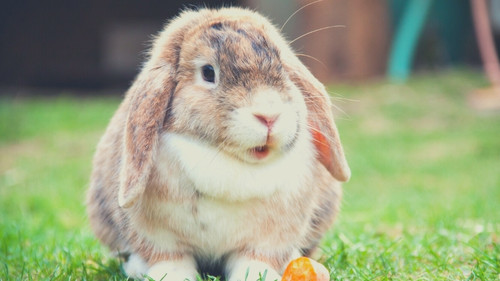
Genital differences are usually what we think of first when we compare male and female animals.
It can be hard to tell a male from a female rabbit when you first look at them, so looking at their genitals allows us to determine their sex.
Bucks have two testicles in an oblong scrotum. There is also a visible prepuce, the skin covering the head of the buck’s penis.
Does have a mound in the shape of a ‘V’ with a slit, which is the outside of their vagina. Dr. Jen Quammen explains that from the side, it can look like a pyramid, and it will be sticking up or out.
Does tend to reach sexual maturity earlier on than males. Both males and females will be sexually mature between four and eight months of age.
2. Personality
When we focus on personality, it’s important to remember that all rabbits are individuals. They have their own personalities, and their behavior will vary depending on many factors. These generalizations are commonly seen, but they may differ slightly.

Male rabbits are usually more naturally friendly than females. They’re more likely to bond with you early on and seek affection.
Typically, bucks are more willing to trust their owners. Does are usually more stubborn and less inclined to trust. They take a bit longer to get to know you and build a bond.
If it’s your first time owning a rabbit, you might find a neutered male is your best choice. Research shows that they are significantly more likely to seek your attention and want to interact with you.
3. Territorial Behavior
Females are generally more territorial and aggressive than males. This is because, in the wild, they would spend more time in their burrow and focus on protecting their babies.
Wild does fight each other for dominance to determine a hierarchy among the group.
Although domestic does don’t need to fight for resources, it comes naturally to them. This means that domestic does will likely fight with other does if you house them together. However, spayed does can live together happily if you bond them carefully.
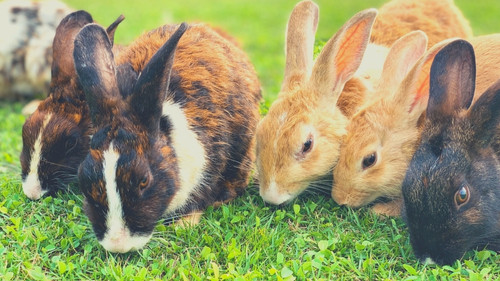
Does are more likely to be aggressive with their owners. You might see this if you’re coming into their living area. They might growl or lunge at you, although they rarely bite. This behavior tends to settle down as they learn to trust you.
On the other hand, bucks are more laid back and relaxed than females. They’re less likely to be aggressive or defend their space. They wouldn’t be in charge of protecting the nest in the wild.
Wild bucks also spend more time away from the warren, so they are naturally less likely to be territorial. However, if they’re housed with other bucks, they are likely to fight in an attempt to establish dominance.
4. Sexual Behaviour
Male rabbits tend to exhibit more sexual behavior because they would in the wild. They also use sexual behavior to establish dominance. This includes humping and mounting other rabbits and animals in the home. You might also see them humping objects like toys or your cushions!
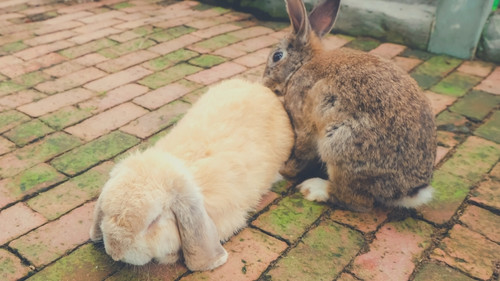
Females are much less likely to display this type of behavior. If a female does mount or hump other rabbits, it’s usually because they’re trying to establish dominance.
Rabbits who haven’t been spayed or neutered are known as ‘intact’. Intact males can be very sexually aggressive. If there’s a female rabbit nearby, they will do everything they can to get to her. They can be quite aggressive in trying to mate her.
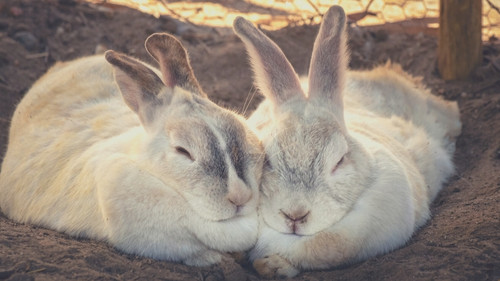
Neutering your male rabbit can help to reduce these sexual urges and therefore reduce the behavior. Neutered bucks and spayed does can live happily together when they’re bonded correctly.
Whether you have a doe or buck, getting them spayed or neutered is a good idea. It makes their behavior more manageable and generally results in a happier bunny. It’s also better for their health and reduces the risk of accidental pregnancy.
The Rabbit Welfare Association and Fund state that sexual behavior is more enhanced during springtime. This is because wild rabbits are particularly fertile during spring and summer. Your rabbit’s hormones will be heightened during this time, even if they’re neutered or spayed.
5. Spraying
Spraying refers to your rabbit urinating around their enclosure and potentially your home. They do this to mark their territory, as they would in the wild.
Both males and females can be prone to spraying, although you more commonly see it in males.
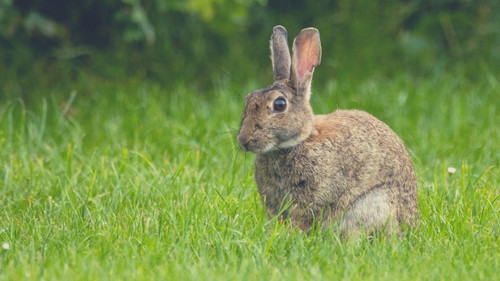
In the wild, males would be the ones to spray around their warren. They do this to let other rabbits and animals know that the area belongs to their colony (meaning their family of rabbits).
Despite it being natural, spraying can be pretty unhygienic and frustrating for us as owners. Thankfully, neutering your rabbit can help to tackle the problem. Litter training can also be helpful, which we’ll discuss later in this article.
6. Destructive Behavior
If you’re a rabbit owner, you’ve likely seen your rabbit digging. This behavior is completely natural and part of being a rabbit!
Your rabbit’s wild relatives do this a lot. When digging is done around your home, it can be quite destructive.
Female rabbits are more likely to dig in the home. You might find them digging at your carpet or their toys. Does are prone to digging behavior because, in the wild, they’re the ones who do most of the digging to form the warren they live inside.
You may see bucks digging for fun, but it’s generally less common than with females. My rabbit was male and loved to dig, but only when we played with him!
Bucks and does both need to chew for a lot of the day! This is a natural urge because it helps to keep their teeth worn down and their digestive system functioning properly.
If your rabbit doesn’t have something appropriate to chew on, they will start chewing anything else they can get their paws on.
Destructive chewing and digging can be bothersome as an owner. The best way to deal with it is to give your rabbit a healthy way to redirect that behavior.
You could provide them with an area where they can dig, such as a sandbox or an area of your garden. Something we would do for our bunny now and then was give him lots of newspaper on the living room floor. He loved digging at it and ripping it up!
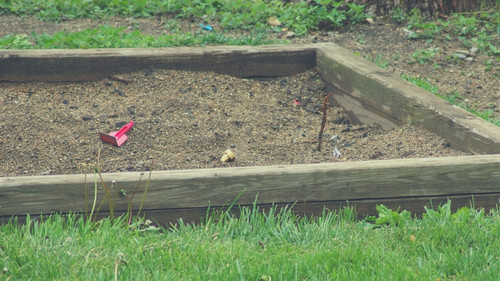
Be sure to supervise your rabbit if you do this to make sure they don’t eat too much of the paper.
To redirect chewing, you can provide plenty of rabbit-safe chew toys. Bunnies should always have access to lots of fresh hay to munch on throughout the day too.
You can also rabbit-proof your home, ensuring you block off unsafe areas or precious belongings. This keeps your bunny safe and prevents them from making a mess of your house.
7. Hygiene
In general, female rabbits tend to be cleaner than males. They usually keep their living area tidier and have better self-grooming habits. Due to this, they tend to smell less than males.
However, this varies greatly depending on the rabbit’s personality.
8. Litter Training
Litter training your rabbit makes cleaning up after them easier and keeps things hygienic in your home. Females tend to be easier to litter train. This is mainly because they are less likely to pee and poop around their living area to mark their territory.
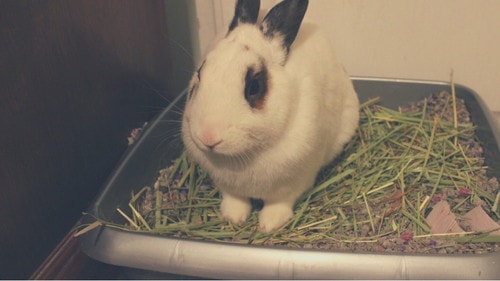
Males are inclined to spray, as mentioned earlier. Getting them neutered can help to reduce this behavior.
Overall, both bucks and does can be successfully litter trained with patience and time.
Male vs Female Rabbit: Which Is Better?
Both male and female rabbits can make excellent pets. Neither is really ‘better’ than the other.
Bucks and does are both great companions depending on your needs. Males tend to be more friendly initially, so maybe better if you’re a first-time bunny owner. You don’t need to deal with much humping or spraying with female rabbits, and they bond with you over time.
Whichever you choose, remember that all rabbits are individuals, so this is just general guidance.
Have you owned male or female rabbits? What differences have you noticed? We’d love you to share your experience in the comments.


